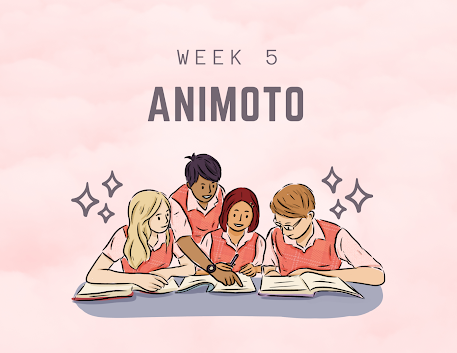Week 5: Animoto Has it All!
Intro
Welcome to my this week's post, where I take a look at how school librarians can benefit from using Animoto! Animoto is an accessible video editing tool for all ages.
Is it Free to Use?
Yes! Animoto is free for students and educators. Sign up through your email and find your school, and you can create an unlimited number of videos!
There are paid plans and upgrades that give students and librarians access to even more content, so that could be something to look into if an educational organization such as a school or library was looking to purchase Animoto.
Features
Animoto allows you to upload and edit videos or to film videos within the site. Animoto lets you add elements such as graphics, colors, music, text, and offers a variety of styles and themes to elevate your videos. It also has all the necessary editing features needed to help you cut and organize your video so it is the best that it can be.
Animoto's templates save students and school librarians a lot of time because they give them a structure to follow. Both are advised to take the original template and add to it and customize it, but it saves you from starting from scratch and wasting time outlining.
Each template has an overview that tells the user what audience/use the template would be the best fit for, where it can be shared, and an overview of the template's various unique features and the purposes it serves. This way, you can browse the templates until you find the best fit. There's also a video attached that shows what the template looks like. This is a good visual aid that will be integral in a user's decision.
Animoto has a free media library that has stock images and videos as well as an audio library where you can use public domain music and sounds in your video.
Accessibility
Animoto has a similar structure and layout to Google Slides and PowerPoint when you are in editing mode. This makes it somewhat familiar and easier to adapt to for people who have used those applications before.
Animoto has specific accessibility features such as timing controls, captions, and voiceover. Timing controls allow you to sync other elements such as images and text with the video, and create affects for each. This gives the user control with how to pace their video, and how to balance the visual and audio elements for an ideal viewing experience.
Use in School Library
Something that inspired me most about Animoto was the various pre-made templates. This helped me brainstorm and think of some ways it can be used in the school library classroom.
I could see Animoto being a great resource for video projects! There is a great book report template that could be used if library students were asked to review books and share it with their peers. The librarian would train the students how to use Animoto. The website is filled with helpful video tutorials. They would spend a class or two practicing using Animoto and learning all of its features. Then, the students would be tasked with making a video reviewing a book they recently checked out of the library and enjoyed. They would film it and work on it in class, and then they'd present their videos as a class. It would help if the librarian made a video too, so the students knew what to model theirs after.
Some other ideas would be to make book trailers, to kick off a class by asking students to make introduction videos, and more!
I could also see librarians using Animoto to make educational videos for class. To avoid copyright, sometimes it is an educator's best best to create their own content. This also helps if the librarian has a big focus on technology in their lessons, because if the librarian is constantly using this application, the students will become more proficient in using it the more they are exposed to it. This would be a win-win situation for both parties :)
Conclusion
If you are looking to incorporate more lessons around creating videos into your library education, Animoto is a fantastic resource! It is user friendly, efficient, and engaging which will capture the attention of your students. It is also something that can be used by educators to create class resources, and used by students for assignments and projects, and even in-class exercises. I've not got the opportunity to use it for a lesson, but I am eager to try!
Resource
Here are some Lesson Plans and Ideas offered by Animoto

Comments
Post a Comment